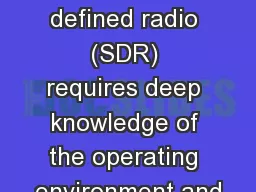

coding A bidirectional transceiver in MATLAB that allows automated selection of parameters Aims to facilitate realtime operation and timing consistency using MATLAB Coder and MEX ID: 642943
Download Presentation The PPT/PDF document "Software defined radio (SDR) requires d..." is the property of its rightful owner. Permission is granted to download and print the materials on this web site for personal, non-commercial use only, and to display it on your personal computer provided you do not modify the materials and that you retain all copyright notices contained in the materials. By downloading content from our website, you accept the terms of this agreement.
Slide1
Software defined radio (SDR) requires deep knowledge of the operating environment and coding.A bi-directional transceiver in MATLAB that allows automated selection of parameters.Aims to facilitate real-time operation and timing consistency using MATLAB Coder and MEX.An example of model-based design, where state and block diagrams drive code development.Designate one machine (DTx) to send DATA, get ACKs and another (DRx) to get DATA, send ACKs.
Gigabit Ethernet
Gigabit Ethernet
Ettus
Research™ USRP™ N210
Hardware Setup
1.1
DTx
waits for a fixed interval of time before
sensing the channel state.
1.2
DTx
either backs off or transmits depending
on whether the
channel state
is busy or
not
.
1.3 DTx contends for channel access.
Graduate
Category: Engineering and TechnologyDegree Level: Ph.D.Abstract ID# 618
Abstract
IEEE 802.11b
physical (PHY) and medium access control (MAC) layer frame structure with some modifications.Differential Binary Phase Shift Keying (DBPSK) modulation scheme. DBPSK improves accuracy as it requires only coarse frequency compensation without any closed-loop techniques. MEX: MATLAB code, generated into C code, compiled into an executable
ResultsTransceive function execution times adhere more closely to expected slot time of 7.04 ms when compiled into MEX. RFFE Block execution times depend mostly on Frequency Resolution parameter; compiling into MEX provides no speedup due to large FFT sizes. AGC parameters control how well a signal can be recovered under various attenuation levels. By parameter sweep, a step size of 0.5 and an update period of 704 minimizes frame misdetection.
ConclusionSystem designed and built with slot time-synchronized operations adheres to our desired frame time and is able to reconfigure parameter values as needed. Using MEX is essential for realizing timing with little deviation from the frame time. In addition, MEX improves the speed consistency of our system blocks, most notably RFFE, which can vary its frequency resolution parameter.
Implementation of a MATLAB-based Self-Configurable Software Defined Radio TransceiverBenjamin Drozdenko (bdrozdenko@coe.neu.edu), Ramanathan Subramanian (rsubramanian@coe.neu.edu), Prof. Kaushik Chowdhury (krc@ece.neu.edu), Prof. Miriam Leeser (mel@coe.neu.edu)
1. Energy Detection
3: Receive ACK Frame
2: Transmit DATA Frame
Designated Transmitter (DTx)
1. Receive DATA Frame
3: Wait DIFS
2: Transmit ACK Frame
Designated Receiver (DRx)
1.1
Wait
DIFS
1.2
Detect Energy
1.3
MAC Contend
Entry: Prepare 802.11b
DATA frame
(256 USRP frames)
During: Prepare new USRP frame
(64 bits ≡ 1408 samples)
Exit: Wait SIFS
Entry: Prepare 802.11b
ACK frame (4 USRP frames)During: Prepare new USRP frame (64 bits ≡ 1408 samples)Exit: Wait SIFS
3
.1 Search SYNC
1
.1 Search SYNC
3
.2 Read Header
1
.2 Read Header
1
.3Read Payload
3
.1
3
.2
1
.1
1
.2
1
.3
Machine 1
Machine 2
Algorithm & Code Structure
function
dRxd
=transceive(d2Tx){
dRxd
= step(
hRx
);
step(hTx,d2Tx);
}
function main() {
while !flagTerminal { dRxd = transceive(d2Tx); if (state==1.1) {...} elseif (state==1.2) ... }}
1
-1
1
-1
Received USRP Data
(post-RFFE, complex
)
Expected Preamble (real)
−
window
Demodulate to get real
bitstream
Expected Scrambled Preamble (real bits)
Descrambled 2
nd
USRP Frame (real bits)
−
window
+
window
Expected SFD Sequence (real bits)
+
window
SYNC Det
DDD
:
RFFE
(RF Front End)
:
SMS
:
:
Perform Coarse Complex Correlation
Future Work
Complete
design of the MAC
functions.
Implement transceiver
system design on the Xilinx Zynq-7000 System-on-Chip (
APSoC
).
References
[1] I. F.
Akyildiz
, S.
Mohanty
, M. C.
Vuran
, and V. Won-
Yeol
, “
NeXt
generation/dynamic spectrum access/cognitive radio wireless networks: A survey,” Computer Networks, vol. 500, no. 13, Sept. 2006.
[2] Ettus Research, Inc., “USRP N200/N210 Networked
Series.”
[3] IEEE
Std
802.11-2009, “Part 11: Wireless LAN Medium Access Control (MAC) and Physical Layer (PHY) Specifications.”
[4] MathWorks.
“Comm.
System
Toolbox Documentation.”
[
5] T
. Collins, “Multi-Node Software Defined Radio TestBed”. NEWSDR 2014.[6] J. Mitola III and G. Q. Maguire, Jr., "Cognitive radio: making software radios more personal," IEEE Personal Communications Magazine, vol. 6, nr. 4, pp. 13–18, Aug. 1999.AcknowledgementsThis work is supported by MathWorks under the Development-Collaboration Research Grant A#: 1-945815398. We would like to thank Mike McLernon and Ethem Sozer for their continued support on this project.
DRx waits for DCF Inter-frame Space (DIFS) duration before re-entering DRx State 1
Background
2
2
CDSP
COMMUNICATIONS & DIGITAL
SIGNAL
PROCESSING